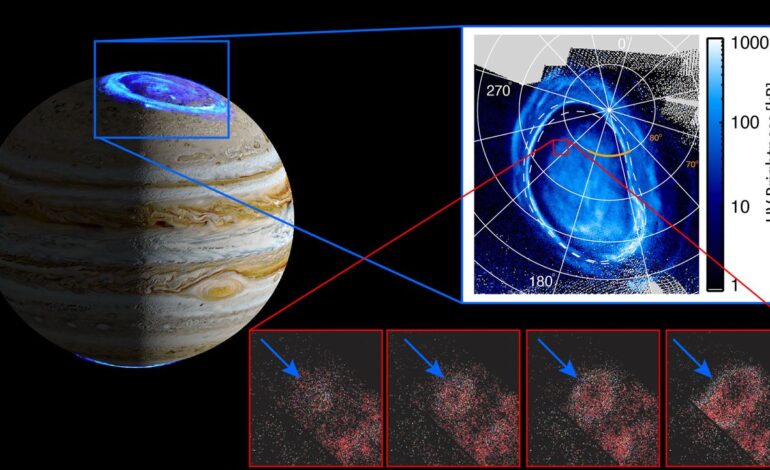Jupiter’s Alien Auroras Unveil New Plasma Wave Discovery

Jupiter’s auroras, known for their dazzling displays, have led to the discovery of a new type of plasma wave, according to researchers from the University of Minnesota Twin Cities. This finding enhances scientists’ understanding of space weather and the behavior of auroras on other celestial bodies.
Auroras occur when charged particles from a planet’s magnetic field collide with its atmosphere. While Earth’s auroras are visible in vibrant colors across the night sky, Jupiter’s auroras are far more powerful and require specialized instruments to observe, as they are typically invisible to the naked eye. The latest revelations about these “alien auroras” were made possible through data collected by NASA’s Juno spacecraft, which has been orbiting Jupiter since 2016.
New Insights from Juno’s Observations
Juno’s unique polar orbit allows it to traverse the planet’s intense radiation belts while capturing detailed measurements of its magnetic field and auroras. The spacecraft’s Waves instrument is capable of detecting electromagnetic signals generated by charged particles interacting with Jupiter’s magnetic field.
According to Ali Sulaiman, an assistant professor of physics and astronomy at the University of Minnesota and co-lead of the study, “The James Webb Space Telescope has given us some infrared images of the aurora, but Juno is the first spacecraft in a polar orbit around Jupiter.”
The study identified a previously unknown plasma wave type, resulting from the unique conditions surrounding Jupiter. Researchers discovered that the plasma density in Jupiter’s polar environment is low while the magnetic field is exceptionally strong, causing the waves to vibrate at unusually low frequencies. This phenomenon creates a new wave type that starts as a familiar Alfvén wave but transitions into what is termed a “Langmuir mode” under Jupiter’s extreme conditions.
Implications for Understanding Space Weather
The findings shed light on the distinct ways plasma behaves in Jupiter’s magnetosphere compared to Earth’s. On our planet, auroras generally form ring-shaped bands around the poles, while Jupiter’s magnetic field directs charged particles into the polar cap, resulting in more concentrated and chaotic auroras.
This research suggests that the conditions observed on Jupiter may be common in the outer planets of our solar system and possibly on exoplanets orbiting other stars. It also raises the possibility that similar plasma waves could exist on strongly magnetized stars.
The research was published in the journal Physical Review Letters on July 16, 2023. The team plans to further analyze Juno’s data as it continues its orbits around Jupiter, potentially revealing more about how plasma behaves in extreme environments and how planets, including Earth, are shielded from harmful radiation emitted by their stars.






